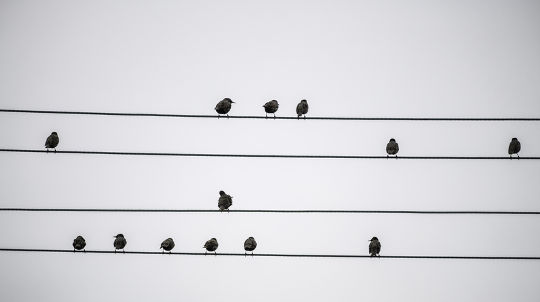
Birds on a wire space themselves out for the same reason that we put distance between the person in front of us in line at the movies.
“It’s an attraction. You want to talk to the person in front of you but you don’t want to be in their personal space,” says Bill Saidel, associate professor of biology at Rutgers University-Camden. “That’s a repulsion. It’s the same thing with birds.”
As reported in the Journal of Theoretical Biology, how birds self-assemble can be explained by the combination of attraction (such as for mating or searching for food) and repulsion (to avoid collisions with group members or because of claustrophobia).
The findings also show that interactions between birds are topological—birds interact with each other based on the closeness of their neighbors on the wire.
Over a two-year period, researchers took hundreds of photos of starlings and pigeons sitting on telephone wires at various locations in Camden County, New Jersey.
After narrowing down the photos to a set of 114, they observed how and where the birds were positioned and measured the distances between them. They then used a systematic quantitative approach to develop a mathematical model to predict the pattern of spacing between individual birds.
“There are a few characteristics where we were able to capture, like, birds are dense,” says Benedetto Piccoli, chair of mathematics, who is also associate provost for research. “If you have a large group, they sit more closely in the center and they are more spaced on the wings and this depends on the species and the bird’s size.”
Using Matlab software, the team scaled the photos, cropped the bird groups in the photos, removed the wires, and took measurements and analyzed the images and the data they found.
Gathering data on the birds and analyzing their behavior was a bit complicated, the researchers say, because they’re up high, and locating and measuring their position wasn’t easy.
“It’s just catch as we could,” says Saidel. “One of the rules of natural behavior is that you can’t tell them what to do.”
The National Science Foundation funded the work.
Source: Rutgers University
Related Books
at InnerSelf Market and Amazon

























